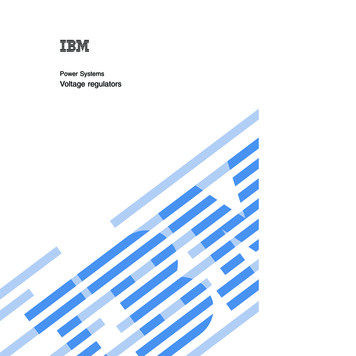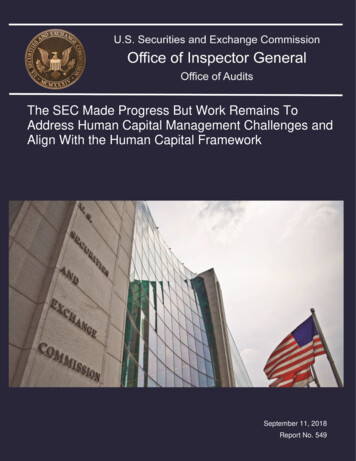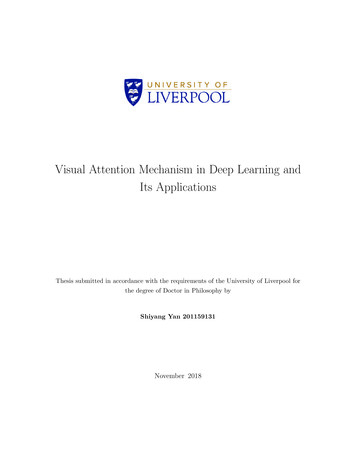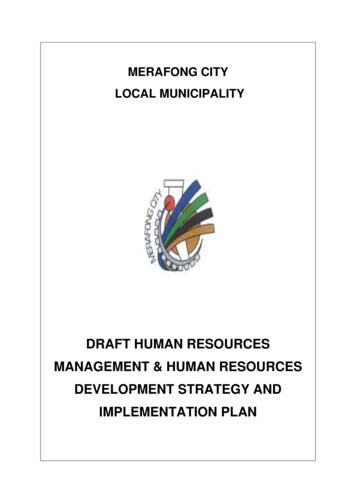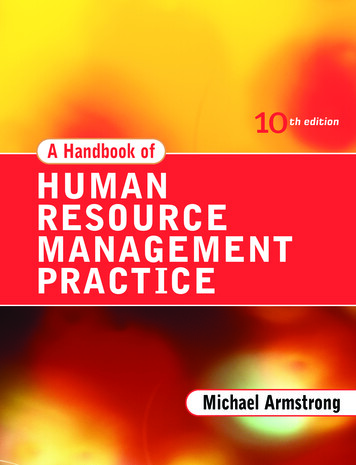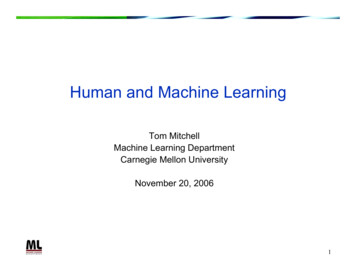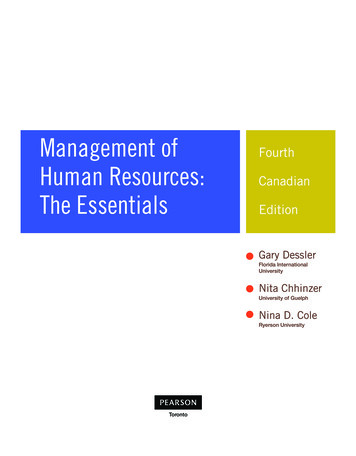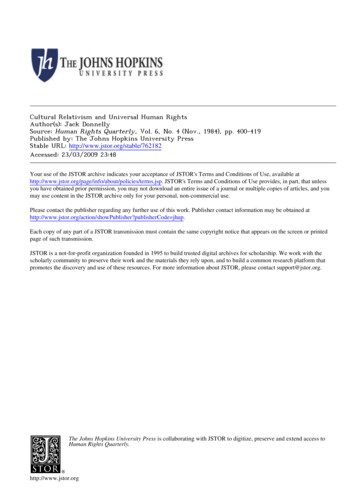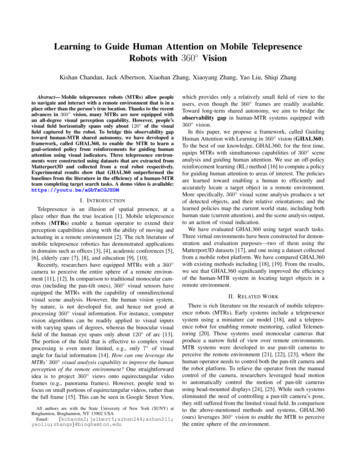
Transcription
Learning to Guide Human Attention on Mobile TelepresenceRobots with 360 VisionKishan Chandan, Jack Albertson, Xiaohan Zhang, Xiaoyang Zhang, Yao Liu, Shiqi ZhangAbstract— Mobile telepresence robots (MTRs) allow peopleto navigate and interact with a remote environment that is in aplace other than the person’s true location. Thanks to the recentadvances in 360 vision, many MTRs are now equipped withan all-degree visual perception capability. However, people’svisual field horizontally spans only about 120 of the visualfield captured by the robot. To bridge this observability gaptoward human-MTR shared autonomy, we have developed aframework, called GHAL360, to enable the MTR to learn agoal-oriented policy from reinforcements for guiding humanattention using visual indicators. Three telepresence environments were constructed using datasets that are extracted fromMatterport3D and collected from a real robot respectively.Experimental results show that GHAL360 outperformed thebaselines from the literature in the efficiency of a human-MTRteam completing target search tasks. A demo video is available:https://youtu.be/aGbTxCGJSDMI. I NTRODUCTIONTelepresence is an illusion of spatial presence, at aplace other than the true location [1]. Mobile telepresencerobots (MTRs) enable a human operator to extend theirperception capabilities along with the ability of moving andactuating in a remote environment [2]. The rich literature ofmobile telepresence robotics has demonstrated applicationsin domains such as offices [3], [4], academic conferences [5],[6], elderly care [7], [8], and education [9], [10].Recently, researchers have equipped MTRs with a 360 camera to perceive the entire sphere of a remote environment [11], [12]. In comparison to traditional monocular cameras (including the pan-tilt ones), 360 visual sensors haveequipped the MTRs with the capability of omnidirectionalvisual scene analysis. However, the human vision system,by nature, is not developed for, and hence not good atprocessing 360 visual information. For instance, computervision algorithms can be readily applied to visual inputswith varying spans of degrees, whereas the binocular visualfield of the human eye spans only about 120 of arc [13].The portion of the field that is effective to complex visualprocessing is even more limited, e.g., only 7 of visualangle for facial information [14]. How can one leverage theMTRs’ 360 visual analysis capability to improve the humanperception of the remote environment? One straightforwardidea is to project 360 views onto equirectangular videoframes (e.g., panorama frames). However, people tend tofocus on small portions of equirectangular videos, rather thanthe full frame [15]. This can be seen in Google Street View,All authors are with the State University of New York (SUNY) atBinghamton, Binghamton, NY 13902 iu;zhangs}@binghamton.eduwhich provides only a relatively small field of view to theusers, even though the 360 frames are readily available.Toward long-term shared autonomy, we aim to bridge theobservability gap in human-MTR systems equipped with360 vision.In this paper, we propose a framework, called GuidingHuman Attention with Learning in 360 vision (GHAL360).To the best of our knowledge, GHAL360, for the first time,equips MTRs with simultaneous capabilities of 360 sceneanalysis and guiding human attention. We use an off-policyreinforcement learning (RL) method [16] to compute a policyfor guiding human attention to areas of interest. The policiesare learned toward enabling a human to efficiently andaccurately locate a target object in a remote environment.More specifically, 360 visual scene analysis produces a setof detected objects, and their relative orientations; and thelearned policies map the current world state, including bothhuman state (current attention), and the scene analysis output,to an action of visual indication.We have evaluated GHAL360 using target search tasks.Three virtual environments have been constructed for demonstration and evaluation purposes—two of them using theMatterport3D datasets [17], and one using a dataset collectedfrom a mobile robot platform. We have compared GHAL360with existing methods including [18], [19]. From the results,we see that GHAL360 significantly improved the efficiencyof the human-MTR system in locating target objects in aremote environment.II. R ELATED W ORKThere is rich literature on the research of mobile telepresence robots (MTRs). Early systems include a telepresencesystem using a miniature car model [18], and a telepresence robot for enabling remote mentoring, called Telementoring [20]. Those systems used monocular cameras thatproduce a narrow field of view over remote environments.MTR systems were developed to use pan-tilt cameras toperceive the remote environment [21], [22], [23], where thehuman operator needs to control both the pan-tilt camera andthe robot platform. To relieve the operator from the manualcontrol of the camera, researchers leveraged head motionto automatically control the motion of pan-tilt camerasusing head-mounted displays [24], [25]. While such systemseliminated the need of controlling a pan-tilt camera’s pose,they still suffered from the limited visual field. In comparisonto the above-mentioned methods and systems, GHAL360(ours) leverages 360 vision to enable the MTR to perceivethe entire sphere of the environment.
Robot(b) Analyzed frame(a) Equirectangular frame(c) Filtered objects in the frameObjectdetection360ControllerCameraObject ofinterestAnalyzedEstimated humanintentionParticle FilterHeadposeframe dataAction(visual indicator)(f) Visual indicators overlaid on theframeCurrent focusedwedge(d) Equirectangular frame loaded as textureon a spherePolicyVisualization(e) Viewport rendered based on humanhead poseHumanGHAL360 Fig. 1: The input of GHAL360 includes live 360 video frames of the remote environment from MTR, and human head pose.(a) Equirectangular frames encode the 360 information using equirectangular projection. (b) Those frames are analyzedusing an object detection system. (c) The detected objects are then filtered to highlight only the objects of interest, whichis a task-dependent process. (d) After the human’s display device receives the equirectangular frames, GHAL360 constructsa sphere, and uses the frames as the texture of the sphere. A human may only view a portion of the sphere, with a limitedfield of view, e.g., as indicated in the red-shaded portion. (e) The portion viewed by the human is called a “viewport”,which is rendered based on the head pose of the human at runtime. (f) GHAL360 overlays visual indicators in real time toguide the human attention toward the object of interest while providing an immersive 360 view of the remote environment.To increase a robot’s field of view, researchers haveequipped mobile robots with multiple cameras [26], [27],and wide-angle cameras [28], [29]. Recently, researchershave developed MTRs with 360 vision systems [19], [12].Examples include the MTRs with 360 vision for redirectedwalking [11], and virtual tours [30]. In comparison to theirsystems, GHAL360 equips the MTRs with a capability of360 scene analysis, and further enables the robot to learnto use the outputs of scene analysis to guide human attention.As a result, GHAL360 performs better than those methodsin providing the human with more situational awareness. Itshould be noted that transmitting 360 visual data bringscomputational burden and bandwidth requirement to therobot [31], [32]. Such system challenges are beyond thescope of this work.Rich literature exists regarding active vision within thecomputer vision and robotics communities [33], [34], [35],where active vision methods enable an agent to plan actionsto acquire data from different viewpoints. For instance, recentresearch has showcased that an end-to-end learning approachenables an agent to learn motion policies for active visualrecognition [36]. Work closest to GHAL360 is an approachfor automatically controlling a virtual camera to choose anddisplay the portions of video inside the 360 video [37], [38].Compared with those methods on active vision, GHAL360has a human in the loop, i.e., it takes the current humanstate into account when using visual indicators to guide thehuman’s attention. Another difference is that GHAL360 isgoal-oriented, meaning that its strategy of guiding humanattention is learned toward achieving a specific goal (in ourcase, the goal is to locate a specific target object).III. F RAMEWORK AND S YSTEMIn this section, we present our framework calledGHAL360, short for Guiding Human Attention with Learn-ing in 360 vision, that leverages the MTR’s 360 sceneanalysis capability to guide human attention to the remoteareas with potentially rich visual information. Fig. 1 showsan overview of GHAL360.A. The GHAL360 FrameworkAlgorithm 1 delineates the procedure of GHAL360 andexplains the different stages as well as the data flow at eachstage. The input of GHAL360 includes κ, the name of atarget object of interest as a string, and objDet, a real-timeobject detection system.After a few variable initializations (Lines 1-4), GHAL360enters the main control loop in Line 6. The main control loopcontinues until the human finds the target object in the remoteenvironment. Once a new frame (F) is obtained, GHAL360analyzes the remote scene using an object detection systemand stores the objects’ names and their locations in adictionary P (Line 9). The location of κ is then stored inL and is used to draw the bounding box over F.If the target object is detected in the current frame(Line 15), Lines 16-24 are activated for guiding human attention. In Line 16 the current egocentric state representation(s) of the world is obtained using the getState function.Based on s, the policy generated from the RL approach(π) returns an action, which is a guidance indicator to00be overlayed on the current viewport (F ), and then Fis presented to the user via the interface. After executingevery action a, GHAL360 updates the Q-values for thestate-action pair using the observed reward (r) and the nextstate (s0 ) in Line 23. Finally, using the new Q-values, thepolicy (π) is updated, and in the next iteration, an optimalaction is selected using the updated policy. The human headorientation (H) is sent to the particle filter as evidence topredict the human motion intention (I). The controller thenreturns the control signal as C based on I to control the
Algorithm 1Require: κ, objDet1: Initialize an empty list C to store the control commands as 2: Initialize a quaternion H (Human Pose) as (0,0,0,0)3: Initialize a 2D image F with all pixel values set as 04: Initialize a dictionary P {}5: π random policy. Initialize a policy6: while True do7:if new frame is available then8:Obtain current frame F of the remote environment9:P objDet(F ). Section III-B10:L P[κ]. Get the location of the object of interest11:Overlay bounding box for object of interest over F12:Render the frame as a sphere. Section III-C13:Obtain current human head pose H014:Render a viewport F to match the human operator’s head pose15:if κ in P then16:s getState(P, κ, H) . Egocentric state representation17:a π(s). Section III-D18:if a lef t or right then019:Overlay the visual indicator on F20:end if021:Present F to the user via the interface22:Observe r and s0. Immediate reward and next state23:Q(s, a) Q(s, a) α [r γ maxa0 Q(s0 , a0 ) Q(s, a)] 24:π(s) argmaxa Q (s, a). Update policy25:end if26:I pf (H). Section III-E27:C controller(I) . Control signal based on human intention28:for each c C do. Section III-F29:ψ τ (c). Generate a teleop message30:ψ is sent to the robot for execution31:Updated map is presented via the interface32:end for33:end if34: end whilerobot motion in the remote environment.In the following subsections, we describe the key components of GHAL360.Once a new frame (F) is obtained, GHAL360 analyzes theremote scene information using an object detection system,where we use a state-of-the-art convolutional neural network(CNN)-based framework YOLOv3 [39]. All the objects(keys) in the frame along with their locations (values) arestored in a dictionary P (Line 9). In our implementation, wedivide the 360 frame into eight equal 45 wedges. Theseeight wedges together represent all the four cardinal and fourintercardinal directions, i.e. [N, S, E, W, NE, NW, SE, SW].Every wedge can have four different values based on theobjects detected in that wedge:W : {w0 , w1 , w2 , w3 }w0 : represents a wedge with no objects detectedw1 : represents a wedge with clutter w2 : represents a wedge that contains only the object ofinterest w3 : represents a wedge containing clutter as well as theobject of interestwhere clutter indicates that the wedge contains one or moreobjects that are not the target object. The output of sceneanalysis is stored as a vector where each element represents C. Equirectangular Frame RenderingOne of the ways to represent 360-degree videos is toproject them onto a spherical surface. Consider the humanhead as a virtual camera inside the sphere. Such sphericalprojection helps to track the human head pose inside the 360 frames. In our implementation, we construct a sphere and useF as the texture information of the sphere. Inside the sphere,based on the yaw and pitch of the human head, the pixels inthe human field of view are identified. Based on the humanoperator’s head pose obtained in Line 13, the viewport isrendered from the sphere. We use A-Frame, an open-sourceweb framework for building virtual reality experiences 1 , forrendering the equirectangular frames to create an immersive360 view of the remote environment.D. Policy for Guiding Human AttentionWe use a reinforcement learning approach [16], QLearning, to let the agent learn a policy (for guiding humanattention) by interacting with the environment. The mathematical representation of the state space is:S : W0 W1 · · · WN 1B. Scene Analysis the status of one of the wedge. The human operator canbe focusing on one of these eight wedges. The getStatefunction in Line 16 takes the output of the scene analysisalong with the target object and current human head poseas input. The output of getState function is an egocentricstate representation of the vector representing the locations ofobjects with respect to the wedge human is currently focusingon (W0 ). The generated egocentric version of the vector isthen sent to the RL agent as the state representation of thecurrent world, including both the output of scene analysisand the current status of the human operator.where Wi represents the state of a particular wedge, asdefined in Section III-B. In our case, N 8, so S 48 ,and s S. The state space (S) of the RL agent consists ofa set of all possible state representations of the 360 frames.All the state representations are egocentric, meaning that theyrepresent the state of the world (locations of objects) withrespect to the wedge human is currently focusing on. Thedomain consists of three different actions:A : {lef t, right, conf irm}where lef t and right actions are the guidance indicators,while the conf irm action checks if the object of interestis present in the currently focused wedge or not. Based ons, the policy generated from the RL approach (π) returnsan action (a), which can be a guidance indicator to enablethe human to find the object of interest in the remoteenvironment. Once the agent performs the action, it observesthe immediate reward (r) and the next state (s0 ). Usingthe tuple (s, a, r, s0 ), the agent updates the Q-value for thestate-action pair. Finally, the agent updates the policy atruntime based on its interaction with the environment. We1 https://aframe.io/
use the BURLAP library 2 for the implementation of ourreinforcement learning agent and the domain.E. Particle Filter for Human Intent EstimationWe use a particle filter-based state estimator to identifythe motion intention of the human operator. In GHAL360,the particle filter is first initialized with M particles:X {x0 , x1 , · · · , xM 1 }where each particle represents a state, which in our case isone of the eight wedges. Each particle has an associated1. The belief state inweight (ω i ) and is initialized as ω i Mparticle filter is represented as:B(Xt ) P (Xt e1:t )where t is the time step, e is the evidence or the observationof the particle filter, and the belief state B(Xt ) is updatedbased on the evidence e1 , · · · , et obtained till time step t.In our implementation, the evidence to the particle filter isthe current change in human head orientation (left or right),and the current focused wedge. As the human starts to lookaround in the remote environment, based on the evidence thebelief is updated:X00B (Xt 1 ) P (X xt )B(xt ))xtAfter every observation, once the belief is updated, wecalculate the density of particles for all the possible states,and the state with more than a threshold percentage ofparticles (70% in our case) is considered as the predictedhuman intention. Once the particle filter outputs the predictedhuman intention (Line 26), we use a controller that outputsa control signal to drive the robot base toward the intendedarea based on the predicted human intention. In case that theparticle density does not reach the threshold in any wedge,the robot stays still until the particle filter can estimate thehuman motion intention.F. Telepresence InterfaceBased on the action suggested by the policy, GHAL360overlays visual indicators over the current viewport. This0results in a new frame F which is presented to the uservia the interface (Fig. 2). The operator can use “click” and“drag” operations to look around in the remote environment.The telepresence interface provides a scroll bar to adjustthe field of view of the human operator. Additionally, theusers can easily change the web-based visualization to animmersive virtual reality 360 experience via head-mounteddisplays (HMDs) via a VR button at the bottom right ofthe interface. In the VR mode, the users can use their headmotions to adjust the view of the remote environment.The telepresence interface also shows the 2D map of theremote environment. Based on the robot pose, a red circle isoverlaid on the 2D map to indicate the live robot location inthe remote environment. Additionally, we show a 2D icon to2 http://burlap.cs.brown.edu/Fig. 2: Telepresence Interface showing the 2D map, the frameof the remote environment, a 2D icon to show human headorientation, a scrollbar to adjust field of view, and a set oficons to indicate the current teleoperation commands givenby the human operator.convey the head orientation of the human operator relative tothe map. The 2D icon also shows the part of the 360 framewhich is in the field of view of the human operator (Fig. 2).The controller in Line 27 converts the estimated humanintention into control command. The control commands areconverted to a ROS “teleop” message and are passed onto the robot to remotely actuate it. Based on the controlcommand, the robot is remotely actuated and the 2D map isupdated accordingly to show the new robot pose.IV. E XPERIMENTSWe conducted experiments to evaluate GHAL360 in atarget-search scenario where a human was assigned the taskof finding a target object in the remote environment using aMTR. We designed two types of simulation environments, 1.Abstract simulation, and 2. Realistic simulation. To facilitatelearning, we designed Abstract simulation to enable the agentto learn a goal-oriented policy for guiding human attention.The learned system is then evaluated in Realistic simulation.The main difference between Abstract simulation and Realistic simulation is that the Abstract simulation eliminates thereal-time visualization to speed up the learning process.A. Abstract SimulationWe use the abstract simulator to let the agent learna strategy to guide human attention toward an object ofinterest in a 360 frame. In our abstract simulation domain,we simulate the process of GHAL360 interacting with the“world” as a Markov decision process (MDP) [40]. Thetransition probability of the human following GHAL360’sguidance (left or right actions) is 0.8 in abstract simulation.There is 0.2 probability that the human randomly looksaround in the remote environment. The transition probabilityof the lef t action and the right action is 0.8 while thetransition probability for the conf irm action is 1.0.The reward function is in the form of R(s, a) R. Afterthe agent takes action conf irm, if the value of W0 (thewedge that the human is focusing on) is either w2 or w3 ,as defined in Section III-B, the agent receives a big reward
(a)(b)(a) Front(c)(e)(d)(f)Fig. 3: (a)-(b), Home dataset from Matterport3D; (c)-(d), Office dataset from Matterport3D; and (e)-(f), Office datasetcollected using a Segway-based mobile robot platform.of 250. If the value of W0 is either w0 or w4 after actionconf irm, the agent receives a big penalty, in the form ofa reward of 250. Each indication action (lef t or right)produces a small cost (negative reward) of 3 if the value ofW0 is w0 or w2 . But if the lef t or right actions result in thevalue of W0 becoming w1 or w3 , then the actions producesa slightly higher cost (negative) of 15.After executing the action (a), the agent moves to a nextstate (s0 ) and receives a reward (r). The reward is basedon the value of W0 which can be one of the four values{w0 , w1 , w2 , w3 } as described in Section III-B, and W0 isthe wedge that the human operator is currently focusing on.If the agent takes action conf irm and transitions to s0 , whereW0 value is w2 or w3 , the agent gets a reward as 250. But ifthe agent takes action conf irm, and the value of W0 is eitherw0 or w1 , the agent gets a reward as 250. The actions lef tand right result in a reward of 3 if W0 w0 , whereas thereward is 15 if the value of W0 w1 or w3 .We trained the agent for 15000 episodes which resulted inthe agent learning a policy for guiding human attention. Wehave evaluated the learned policy in the realistic simulation.B. Realistic SimulationWe used the equirectangular frames from the Matterport3D datasets (Fig. 3(a) - 3(d)) as well as frames fromthe 360 videos captured from the real world (Fig. 3(e) 3(f)), and then simulated human and robot behaviors to buildour realistic simulation. We used a Segway-based mobilerobot platform to capture the 360 videos (Fig. 4). The robotis equipped with an on-board 360 camera (Ricoh ThetaV), and was teleoperated in a public space during the datacollection process.(b) BackFig. 4: Segway-based mobile robot platform (RMP-110) witha 360 camera (Ricoh Theta V), mounted on top of the robot,and laser ranger finder (SICK TiM571 2D) that has been usedfor prototyping and evaluation purposes in this research.We model a virtual human in the realistic simulationthat can also look around in the remote environment andsend control signals to teleoperate the simulated robot usingthe interface. Moreover, as opposed to abstract simulation,the actions of the virtual human can be visualized in theinterface, for example, if the virtual human looks to the left,the viewport is changed accordingly in the interface. Thevirtual human can both track the location of the simulatedrobot through the 2D map and perceive the 360 view ofthe remote environment via the telepresence interface. In ourrealistic simulation, the robot navigates in the 2D grid. If thevirtual human tries to move to an inaccessible position, therobot stays still. Based on the control signal, the location ofthe robot is changed, and the interface is updated accordingly.C. Baselines vs. GHAL360We compared GHAL360 using a target-search scenariowith different baselines from the literature. We also conducted ablation studies to investigate how individual components of GHAL360 contribute to the system. The differentsystems used for comparison are as follows: MFO: Monocular Fixed Orientation based MTR, wherethe remote user needs to rotate the robot to look aroundin the remote environment [18]. ADV: All-Degree View systems which are typicalMTRs equipped with a 360 FOV camera. The humancan use an interface to look around in the remote environment without having to move the robot base [19]. FGS: Fixed Guidance Strategy system which consistsof a scene analysis component along with a hand-codedguidance strategy that greedily guides the human usingthe shortest path to the target object. RLGS: Reinforcement Learning-based Guidance Strategy system uses the policy from RL to guide the humanattention and suggests an optimal path for the humanoperator to locate the target object.FGS and RLGS are ablations of approach, and the comparisons of FGS and RLGS with GHAL360 are ablation studies.We used three different environments: two from the Matterport3D datasets, and one dataset collected from the real-
500(e) Viewport 5250(a) Viewport 1Laptop(c) Viewport 3(b) Viewport 2Cumulative Reward(d) Viewport 40-250-500-750-1000FGSGHAL360-1250-1500Fig. 5: Map showing the trajectory of the robot in the remoteenvironment looking for a “laptop.” The arrows show thedifferent human orientations along the trajectory; The imagesmarked as (a)-(e) are the different viewports of the humanat every orientation shown by the arrows.world. In every environment, there were six sets of startpositions for the robot in each of the environments, witheach set includes positions of the same distance to thetarget. For each environment, we selected two target objects,and each of the target objects was specifically selected toensure that they were unique in the environment to avoidthe confusion resulting from finding a different instanceof the same object at different locations. For example, thetarget objects selected in environment 1 were “backpack” and“laptop”, while the target objects selected in environment2 were “bottle” and “television”. The initial orientation ofthe robot was randomly selected, and a set of one thousandpaired trials were carried out for every two-meter distancefrom the target object until 12 meters. The virtual humancarried out one random action every two seconds out of“move forward”, “move backward”, “look left”, and “lookright” in the baselines (MFO and ADV). The actions “moveforward”, “move backward” are also carried out randomlyin FGS and RLGS, while the actions “look left” and “lookright” are carried out randomly only until there are novisual indications. In case, there are visual indications, thehuman follows the indications with a 0.95 probability. Usingthese actions, the simulated user could explore the remoteenvironment. Once the target object is in the field of viewof the human operator, the trial is terminated.D. Illustrative TrialConsider an illustrative trial where the human-MTR teamneeded to locate a laptop in a remote environment. Fig. 5shows the map of the remote environment with the robot’strajectory marked in blue color. The arrows in Fig. 5 indicatethe different human head orientations, and the red dottedlines point to the different viewports at these orientations.Fig. 5 (a) shows the initial viewport of a virtual human.The human started to look around at the remote environmentto locate the laptop. Fig. 5 (b) shows the second viewportafter the human looked left. Then the human again looked02.5k5k7.5k10kNo. of episodes12.5k15kFig. 6: Comparison of the cumulative reward between FGSand GHAL360. Results show that the learned policy ultimately performed better than FGS (hand-coded baseline).right, and the viewport can be seen in Fig. 5 (a). Thehuman kept looking at the same position for next two timesteps. The particle filter estimated the human’s intention, andaccordingly, the controller output control signals to drive therobot to the next location.The human continued to look around to find the laptop,and the particle filter constantly estimates the human motionintention resulting in the robot moving to different locationsas shown by the blue marked trajectory in the map (Fig. 5).Finally, the robot reached location where the target objectwas located. As soon as the robot reached the location ofthe target object, the scene analysis component detectedthe laptop in the frame, and using the human head pose,GHAL360 overlayed the visual indicator over the viewportas seen in Fig. 5 (d). The indicator suggested the humanto look right to find the laptop, but at first the human didnot follow the guidance and looked left. Again, the visualindicator was overlayed on the new viewport to guide thehuman attention (Fig. 5 (c)). Now, at this time step, thehuman looked in the guided direction, and the viewportchanged back to Fig. 5 (d). Finally, the human followed thevisual indicator and looked further right, and Fig. 5 (e) showsthe resulting viewport of the human with the laptop. Oncethe human found the target object, the trial was terminated.E. ResultsFrom the 15000 training episodes, we extracted 150 different policies after each batch of 100 episodes, and testedthem in our realistic simulation. Fig. 6 shows the averagecumulative reward and standard deviations over five runs.We plotted the mean cumulative reward (Fig. 6) of FGSand GHAL360 to compare the performance of hand-codedpolicy with the learned policy of GHAL360. The x-axisrepresents the episode number while the y-axis represents thecumulative reward. Fig. 6 shows that in the early episodeswhen the agent is still exploring, the cumulative reward forGHAl360 is much lower than FGS. But with the increasingnumber of episodes, it can be observed that GHAL360outperforms FGS which represents the learned policy issuperior to the hand-coded policy.
120010008006004002000246810Distance from the target in meters(a) Env 1: Matterport3D (Home)121200MFOADVFGSRLGSGHAL3601000800Average time in secondsMFOADVFGSRLGSGHAL360Average time in secondsAverage t
Robots with 360 Vision Kishan Chandan, Jack Albertson, Xiaohan Zhang, Xiaoyang Zhang, Yao Liu, Shiqi Zhang Abstract—Mobile telepresence robots (MTRs) allow people to navigate and interact with a remote environment that is in a place other than the person's true location. Thanks to the recent advances in 360 vision, many MTRs are now .
